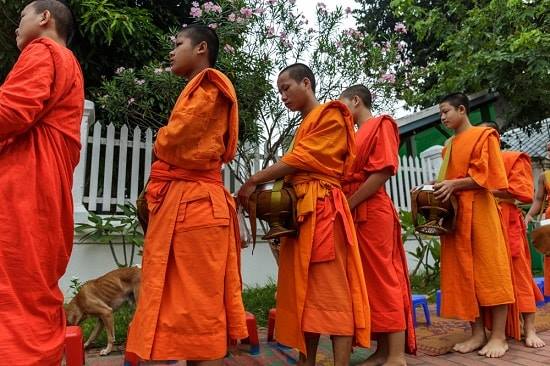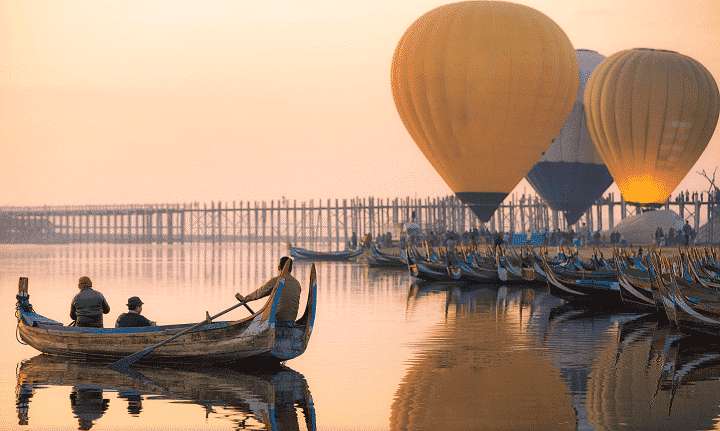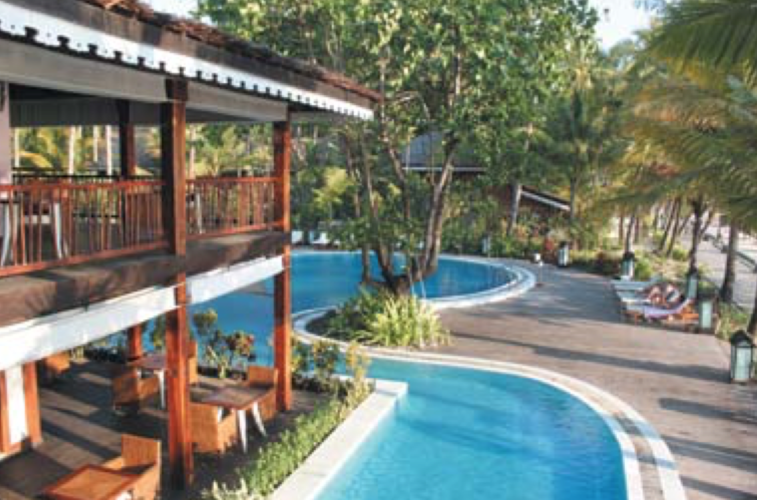MYANMAR TRAVEL TIPS
MYANMAR TRAVEL GUIDE & INFORMATION
Travelers are discovering Myanmar’s incredible sites, from the ancient ruined cities, temple-strewn plains and ornate royal palaces to the faded grandeur of Burmese sedate hill stations and colonial architecture. Myanmar travel also offers a multitude of natural attractions; its glorious scenery and mystical landscapes stretching from the Himalayan foothills to the deserted islands of the south. deep-rooted Buddhist beliefs and spirit worship have provided courage and resilience to the people of Burma in difficult times and their age-old cultural traditions and religious practices form the basis of myriad colourful festivals. It is these, and more simple day to day encounters, that provide the visitor with wonderful opportunities to interact with Burma’s remarkably friendly and hospitable people. Probably the country’s greatest asset, it is the infectious spirit of the people you will meet, and time spent learning about their unique way of life that is the source of many visitors’ fondest memories.
Find out seamless itineraries planned by experts on Best deal myanmar holiday packages
Myanmar Facts & quick Information for travelers
- Area: 671,000 sq km
- Population: 54 million [2019]
- People: 65% Burmese, 10% Shan, 7% Karen, 4% Rakhine and Chin, Kachin, Mon, Chinese, Indian and Assamese minorities
- Language: Kachin, Karen, Burmese, Shan Religion: 87% Theravada Buddhist, 5% Christian, 4% Muslim, 3% animist
- Time difference: GMT+6.5 hours
- Currency: Burmese Kyat (MMK)
Myanmar Visas
Check with your nearest Burmese embassy regarding visa requirements for travel to Myanmar, as they change frequently. A valid passport is the only thing you need since you can apply for a visa to enter Myanmar through the giverment portal. Citizens of alomsot any country is granted to apply the online Burmses visa. A tourist visa’s validity is for 28 days and as of 2019 it cost US$ 50. Most ASEAN countries can get a 14-day visa exemption valid for 14 days. Singaporean will have granted for 30 days. Travel agencies along Bangkok’s Khao San Rd specialize in getting quick tourist visas for Myanmar. Rates depend on turnaround times, which always aren’t met. The process at the Bangkok embassy can take a couple of days. It may be easier to plan ahead and arrange the visa in a ‘quieter’ capital, such as Phnom Penh or Vientiane or perhaps in Hanoi.
Crossing into Thailand: It is relatively straightforward to make the overland crossing from Kyaingtong to Mae Sai in Northern Thailand or vice versa, though it does involve a half day drive along imperfect roads. This is an interesting and intrepid way of combining the beauty and unique culture of far-eastern Shan state with the varied sights and activities of Thailand’s Golden Triangle.
What to Pack for Traveling Myanmar
Myanmar is a semi-tropical and a hot country to travel. Do not overload your suitcase: take light clothes and everything you need to protect yourself from the sun. If you forget your sunscreen, you can try thanaka Myanmar: it is a white-yellow paste of plant origin that Burmese (especially women) use to protect themselves from the sun. Plus, do not forget bikini and swim wear clothes to enjoy paradise on Earth. Traveling in some areas in Myanmar can be cold, especially in Pwin Oo Lwin, Kalaw and Inle Lake. At night, temperatures are around 5 to 10 degrees from November to February. It is advisable to bring warm clothes, especially if you are staying around Inle Lake, where most of the hotels are on stilts.
Is is safe to travel to Myanmar (Burma)?
Usually the only time a local will be running with your money or belongings is if they’re chasing you down the road with something you’ve dropped. For now theft remains quite rare, but don’t tempt fate in this poor country by flashing valuables or leaving them unguarded. Without a doubt, it is safe to travel to Burma and it is a country that we recommend 100% for your next Asian adventure. Rubbing tourists in Myanmar are extremely rare. Traveling to Burma is safe, but it is very important to act with utmost respect for their traditions and religions. Of course, when visiting any temple or religious building you have to be respectful and follow the rules indicated. Particularly important is not to wear tattoos with symbols of the Buddhist religion, especially of Buddha images and especially if they are located from the hip down. If it is the case that you already have a tattoo like this, try to keep it covered.
Myanmar Travel Planning
Best Time to travel
November through to February is the best time to visit. Temperatures can get quite cold in the hills, and close to freezing in places such as Kalaw. From mid-February, it gets increasingly hot – April being the ‘cruellest month’, to quote TS Eliot, until rains bless the land from mid-May through to mid-October. The ideal time to visit Burma is during the dry season, between late October and March. Certain regions can be very wet from July to September, but due to the size of the country it is possible to avoid these areas and still plan a worthwhile tour. From April to July the plains of Bagan and Mandalay are very hot, but the sunshine is interrupted by short, heavy showers. By contrast, the mountain areas can be cold from October to February, as can early mornings and evenings at Inle Lake. It is worth considering travelling during the wet season as visitor numbers decline and preferred hotels are more readily available.
Accommodation options and places to stay in Myanmar
In the key locations of Yangon, Inle Lake, Bagan and Mandalay there are a number of beautiful boutique hotels but demand often outstrips their limited supply of rooms. A number of new hotels are planned and capacity is set to increase over the coming years which should provide some healthy competition and stabilise the steadily increasing hotel prices. We will always try to organise accommodation in one of our preferred hotels but advise you to book at least 9 months in advance if where you stay is key to the enjoyment of your trip. More established areas such as Yangon, Mandalay and Inle lake now have a wide range of accommodation, but only a few of them are our preferred options, in Bagan this is even more apparent. Securing the most comfortable or best located properties means booking early otherwise a flexible approach to expectations is needed. In some areas the only accommodation is simple, functional and friendly.
Money & costs
Burmese Kyat covers the little things (bottles of water, renting a bike, some rice), while dollars are usually requested for ferries, air tickets, hotels and museums. While inflation has skyrocketed in recent years, costs in US dollars don’t fluctuate much. Be sure to carry all the US dollars you need and more. Crisp, new US$100 bills attract the best exchange rates. Small bills are useful for guesthouses, most of which price rooms in dollars rather than kyat. The euro is also increasingly being accepted.
Daily budget
Myanmar is slightly cheaper and more affordable to travel compared to neighboring Laos, Thailand, Cambodia and Vietnam. A daily budget of US$ 35 for those traveling cheap would cover a basic guesthouse, a cheap meal and let you travel around with a local transport. ATM’s were rare to find back to few years ago, however, you can find them in big cities like Yanon and Inle Lake as well as Bagan, however, remember the ATM fee will give you a headache, we head US$ 3 and more per transaction. Try to carry enough cash to cover your trip.

Road travel in Myanmar (Burma)
Totaling 1,154 kilometers in length, the Burma Road links Lashio, north of Hsipaw, to Kunming in China’s Yunnan Province. It was built by the Chinese in 1939 to assist the movement of supplies (which arrived by air or sea into Yangon and were then transported by rail to the Lashio terminus) during the Sino-Japanese War and later, World War II. When the Japanese occupied Burma and closed off the route, Allied forces in eastern India were forced to supply China’s nationalist KMT army by air, navigating a treacherous passage known as ‘the hump’ – 800 kilometres of Himalayan wilderness. This led to the colossal task of constructing a new supply road from Ledo in Assam, through Myitkyina in northern Burma and connecting with the Burma Road at a point still in Chinese hands.
Today the main Lashio-Kunming route is still heavily used for ferrying all manner of goods between the two countries. For the traveller, exploring this section of Burma along with a tour of Yunnan Province is an exciting and insightful journey, truly off the tourist circuit. Lashio is reached by road or rail from Hsipaw and has a colourful market where the Palaung tribes from the surrounding area gather to buy and sell their produce. It is then a short but interesting journey to the Muse border crossing into China. From here, the highlights of Yunnan Province, including Lijiang, Tiger Leaping Gorge and Dali, are all within reach.
Traveling on River cruises in Myanmar
Throughout Burma’s history, river travel has been an important part of everyday life. Today is no different and we recommend incorporating a river journey into your itinerary. There are set departure dates for trips of different durations, making a cruise a good starting point to planning any tour of Burma. There are local ferries and day cruisers that complete the journey between Bagan and Mandalay in around 12 hours. One of our favourites is the R/V Panorama which has a small restaurant on board and a sun deck, from which views of life along the river slowly unfurl making this a very peaceful way to travel. If you have a little more time, the most comfortable options are the one to four night cruises between Bagan and Mandalay that operate between October and April. Longer cruises into the upper reaches of the Ayeyarwady and Chindwin rivers are available at specific times of the year when water levels provide access to these remote regions. Here we feature a selection of our favourite boats for exploring Burma’s rivers at an unhurried pace.
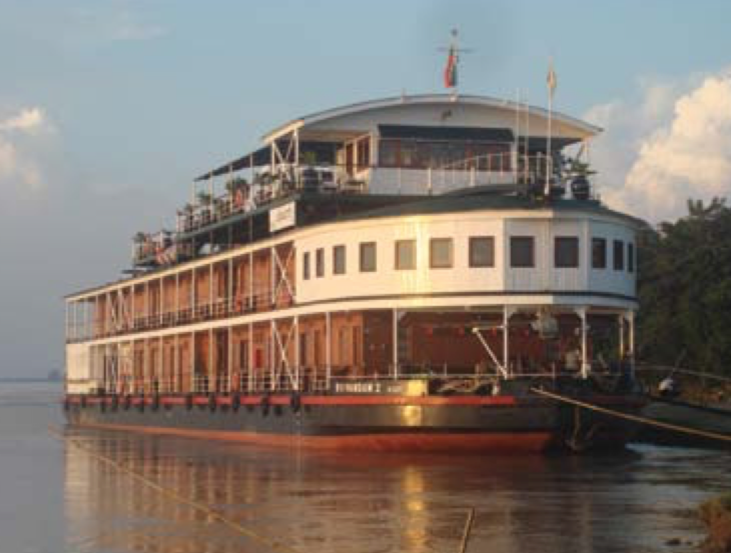
The R/V Paukan vessels have broad promenade decks, a spacious observation lounge and dining room beautifully recreating the atmosphere and character of classic river steamers. There are also modern luxuries available however, such as double berths, suites and massage rooms. Short discovery cruises of one and two night durations are available as well as slightly longer voyages of four and five nights that allow for more in-depth sightseeing between Bagan and Mandalay.

The R/V Paukan vessels have broad promenade decks, a spacious observation lounge and dining room beautifully recreating the atmosphere and character of classic river steamers. There are also modern luxuries available however, such as double berths, suites and massage rooms. Short discovery cruises of one and two night durations are available as well as slightly longer voyages of four and five nights that allow for more in-depth sightseeing between Bagan and Mandalay.
The Belmond Road to Mandalay provides a comfortable vantage point from which to absorb the surrounding beauty of the Ayeyarwady. All 43 cabins are carefully designed and equipped with en suite bathrooms and air conditioning and on deck there is a swimming pool and shaded seating. The Belmond Road to Mandalay offers three, four and seven night cruises between Mandalay and Bagan. In August and September, an 11 night cruise sails northwards through breathtaking gorges and forgotten villages to Bhamo, close to the Chinese border.
R/V Pandaw: The well-respected Pandaw cruise company operates a range of in-depth river voyages in Burma on the Ayeyarwady, Chindwin, Kaladan and Salween rivers, visiting many places that cannot be reached by land. Pandaw operate a number of vessels that are hand-finished with teak and brass fittings reminiscent of colonial days, and modelled on the Irrawaddy Flotilla Company’s original river steamers with ultra-shallow draughts. The majority of expeditions are all-inclusive boutique cruises with no hidden costs: excursions, full board, soft drinks, local beer, local spirits and even tipping for the crew are all included. Pandaw has a strong commitment to supporting various projects throughout Burma, and with the help of its passengers has raised funds for new schools and medical facilities.
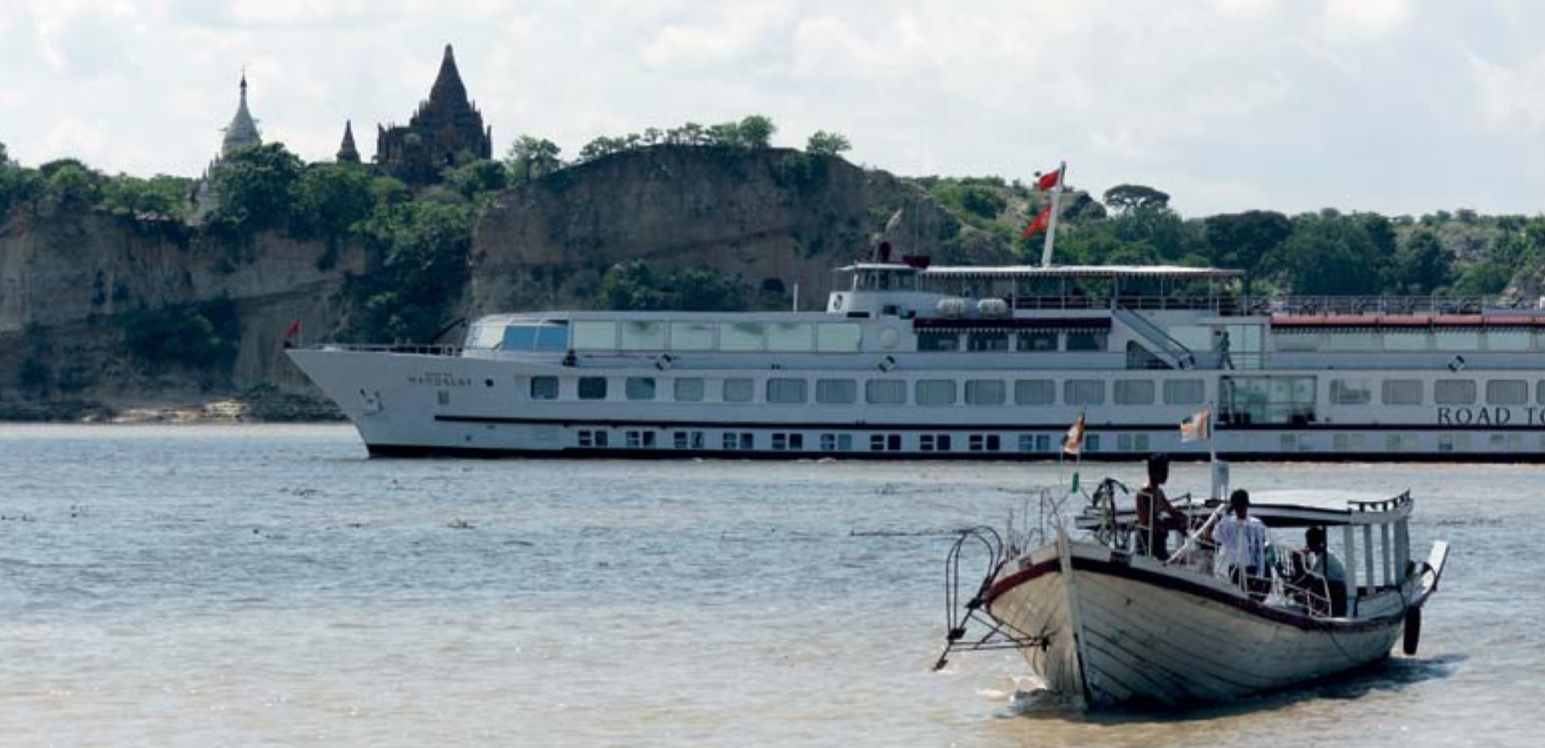
The Sanctuary Ananda provides a luxurious cruising experience on both the Ayeyarwady and Chindwin rivers and offers a selection of short and longer cruises. All 21 spacious suites have their own balconies and combine traditional Burmese design elements with contemporary comforts. All suites on the Bhamo Deck offer butler service. There are also two pairs of interconnecting cabins available for families as well as the option of an extra bed in four of the suites. Dining experiences can be enjoyed al fresco or in the air-conditioned Talifoo Restaurant. There is a spa, fitness centre and library as well as a lounge offering panoramic views and a sun deck with plunge pool.
The Belmond Orcaella is another beautiful vessel belonging to the Belmond portfolio of luxury offerings in Burma. The elegant four-deck river cruiser provides unparalleled service and great attention to detail. The ship’s small size and shallow draught enable it to ply remote areas of the Ayeyarwady and Chindwin rivers, providing passengers with an opportunity to discover this magical country’s rich heritage, natural beauty and friendly people. Each of the 25 spacious cabins features air conditioning, floor-to-ceiling sliding glass doors, private balconies and en suite facilities. On the observation deck there is a dedicated relaxation area with a small pool, retractable awning and reclining chairs providing the perfect vantage point to watch the scenery pass by. A lounge and bar, which is open all day for refreshments and al fresco dining, is the social hub of the ship. All journeys include many delightful touches including local entertainment, informative and interactive lectures, cocktail parties, and yoga and meditation on the observation deck.
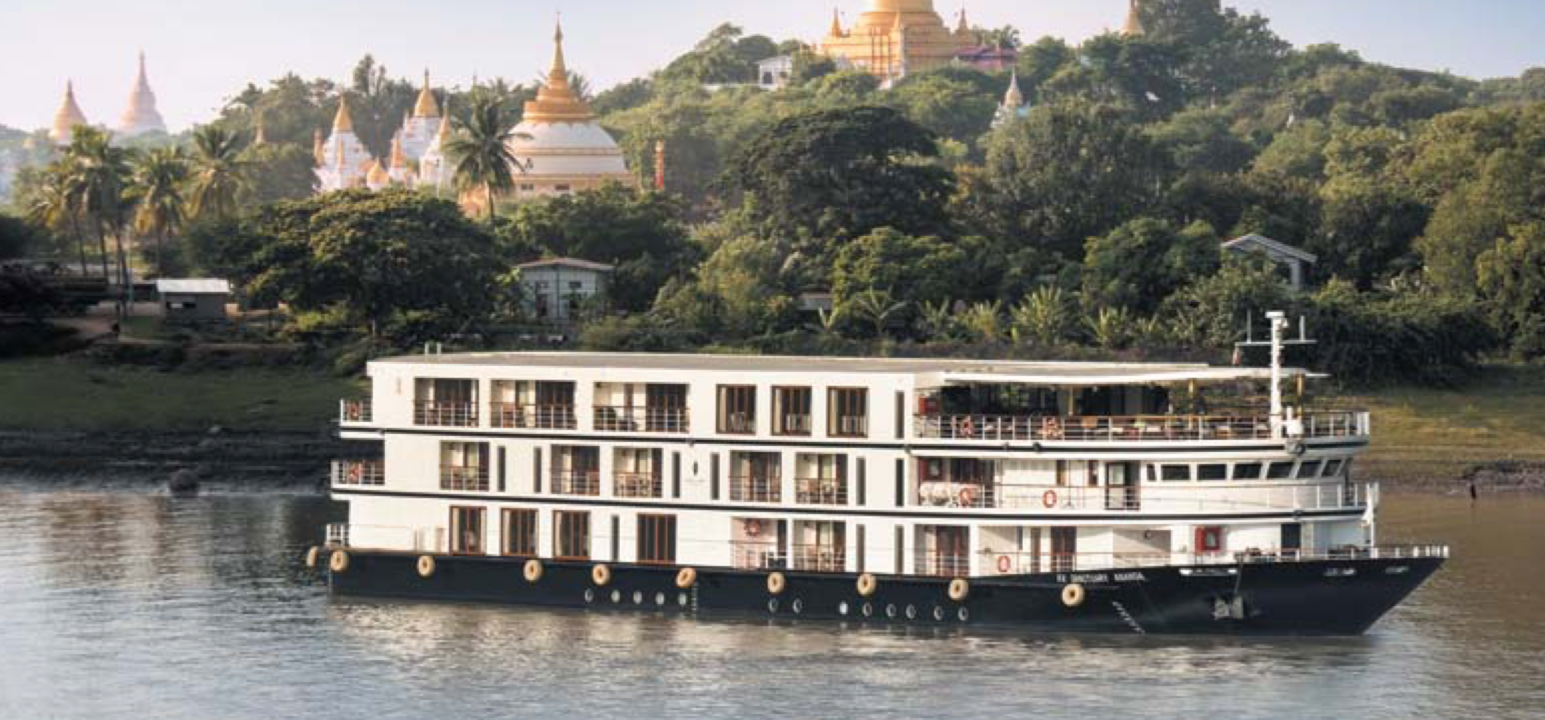
Best & top things to do in Myanmar (Burma)
Shwedagon Paya
Visible from almost anywhere in Yangon, this is one of Buddhism’s most sacred sites. The 325ft zedi , adorned with 27 metric tons of gold leaf and thousands of diamonds and other gems, is believed to enshrine eight hairs of the Gautama Buddha as well as relics of three former buddhas. Four long, graceful entrance stairways lead to the main terrace which, depending on the time of day you visit, can be quiet and contemplative or bustling and raucous. If you prefer the former, visit in the cool of dawn. Otherwise pay your respects when the golden stupa flames crimson and burnt orange in the setting sun.
Kyaiktiyo (Golden Rock)
The excursion to the incredible balancing boulder stupa, called Kyaiktiyo (or Golden Rock), is a must-do. The small stupa, just 7.3m (24ft) high, sits atop the Gold Rock, a massive, gold-leafed boulder delicately balanced on the edge of a cliff at the top of Mt Kyaikto. This is one of the most sacred Buddhist sites in Myanmar.
Bogyoke Aung San Market
Half a day could easily be spent wandering around this sprawling covered market, sometimes called by its old British name, Scott Market. It has over 2000 shops and the largest selection of Myanmar handicrafts and souvenirs you’ll find under several roofs, from lacquerware and Shan shoulder bags to puppets and jewellery. Pick up some nice slippers here, convenient for all the on-and-off demanded by paya protocol, and a longyi ; U Maung Maung in the main hall has a good selection ranging from cotton ones for K5500 to silk-mix ones for K9500. Other shops worth seeking out include Yo Ya May (1st floor), specialising in hill tribe textiles, particularly those from Chin State, and Heritage Gallery , next door, which has a good selection of reproduction and authentic antiques with an emphasis on lacquerware.
Yangon (Rangoon)
Yangon, the former capital of Burma, still retains much of its colonial character in the grand buildings of the downtown area and the old mansions of the Diplomatic Quarter. In contrast to this, the magnificent Shwedagon Pagoda is a vivid demonstration of Burmese faith, with a stream of devotees bringing offerings to the various shrines within the temple complex. The city has an eclectic mix of cultures and religions, with the golden spires of many ancient pagodas glistening alongside modern-day Hindu and Chinese temples, cathedrals and mosques. The bustling streets and narrow alleys of downtown Yangon capture the diversity of this intriguing city: tea houses thick with the smoke of cheroots, the markets of Chinatown bursting with an unfathomable array of goods and the aroma of freshly-milled spices carried on a breeze from the Indian Quarter. In the evening soak up the atmosphere of 19th Street, a lively thoroughfare lined with barbecue stalls and beer stations at which locals play cards and share conversation for hours. Well known for its shops and markets, and more recently its burgeoning art scene, it is worth seeking out Yangon’s Bogyoke Aung San Market (or Scott Market) and the galleries and antique shops in various parts of the city. With finite accommodation options here, early booking is an advantage.
Around Yangon
Looping around Yangon and its suburbs, the city’s circle train is a scenic introduction to the city and an opportunity to observe the everyday life of the Burmese people. If you want to explore further, we recommend a day trip to the nearby town of Twante. This involves a local ferry journey across the Yangon River, a colourful and memorable experience. You can combine a visit to Twante’s traditional pottery workshops with a visit to the Paya Ngoto School which, with help from our clients, Audley raised funds to rebuild after it was destroyed by a cyclone in 2008, and we continue to support. We also suggest walking through Htaukkyant, Yangon’s poignant World War II cemetery on the outskirts of the city, which can be combined with a visit to the pagodas around Bago (Pegu), where local worshippers pay homage to huge Buddha images. Bago can be visited as a day trip from Yangon by road or train, or as you travel further afield.
Ngapali Beach
The beautiful, unspoiled stretch of coast at Ngapali Beach, offers white sands, crystal-clear waters and a glimpse of an authentic working beach. Beneath the swaying palms and casuarina trees you will find simple thatched houses and bustling local markets in this small and charming spot. Reached only by air, the hotels here are only open from October to May.
Mawlamyine (Moulmein)
Mawlamyine was the first capital of ‘British Burma’ and was once a strategic port and shipbuilding centre. Today, its grand, historic buildings stand neglected as modern purpose- built developments take their place. The town’s most famous landmark, the Moulmein Pagoda, was immortalised in Kipling’s poem Mandalay and the city’s colourful mosques and the nearby Yele Paya, an island pagoda, are good places to experience Burma’s spiritual side. Not far from here at Thanbyuzayat is the western terminus of the Thai-Burma Railway and the War Cemetery, a well-kept memorial to the Allied troops lost in World War II. Reached by a full day’s drive from Yangon, Mawlamyine sees few visitors but combined with Golden Rock and Hpa-An, can make for an interesting insight into the cultures of the Mon and Karen communities that live here.
Hpa-An
Hpa-An is the small but bustling capital of Kayin state, close to the border with Thailand and rarely visited by Western travellers. The town itself is of little note but the surrounding scenery and its authentic charm make it an interesting stop en route between Yangon and Mawlamyine. Hidden in the limestone mountains that surround the town is the impressive Kawgun Cave discovered in 1975. It contains thousands of tiny clay Buddha images and carvings dating from the 7th century. Tucked away in precarious positions all over the walls and roof of the main cave, it is an astounding work of devotional art. There is a small property on the edge of town, flanked by limestone mountains and facing Mount Zwekabin, which makes for a pleasant overnight stay.
Mandalay
The last capital of Burma before British colonialism, Mandalay is the country’s second largest city. It is still considered to be the cultural capital, as well as the economic and religious centre for Upper Burma. Visit the Shwenandaw Pagoda, its walls adorned with exquisite woodcarvings, the Mahu Muni Buddha now misshapen with layers of gold leaf applied by devotees, and the Kuthodaw Pagoda, home to the world’s largest book. It is also worth climbing to the top of Mandalay Hill to watch the sunset over the city. However, to really get under Mandalay’s skin we recommend visits to its vivacious markets including the huge jade market and railway bazaar, where locals ply their trade on the railway track only to have to scatter each time a train comes along. Mandalay is also well known for its handicrafts and is the ideal place to search out marble, wood carvings, weavings or traditional puppets. Accommodation options are broader with early planning.
Hsipaw
Hsipaw is a small and atmospheric town that is well worth a few days of exploration. It was once the capital of an autonomous Shan state and a modest Shan palace still stands. From Hsipaw, it is possible to trek into the surrounding hills and take boat trips to the confluence of the Namtu and Dotawaddy rivers, stopping at small local villages and riverside monasteries en route.
Goteik Viaduct
Heading north from Pyin Oo Lwin, a six hour train journey takes the hardy traveller through some of Shan state’s most picturesque countryside and across the impressive Goteik Viaduct to Hsipaw. Built in the early 1900s by Pennsylvania and Maryland Bridge Construction on behalf of the British, this imposing steel bridge spans a 300 metre deep gorge. The train makes a slow and steady crossing through this remote, jungle-clad landscape presenting some of the most breathtaking views in Burma. The journey is well worth it but it is also possible to travel along just a small section of the track from Naung Cho to Kyaukme, which lasts only a couple of hours.
Monywa
Not many visitors reach Monywa and it is all the more special for this. Situated on the eastern bank of the Chindwin River, it is an interesting town to explore and a convenient rest point if making the journey overland between Mandalay and Bagan. The town is approximately 140 kilometres to the west of Mandalay and is home to some impressive rock-hewn temples on Shwe Ba Hill and the sandstone caves of Hpo Win Daung. There is a simple hotel in Monywa which has pleasant cottage-style rooms set in lush gardens.

Bagan (Pagan)
Along with the temples of Angkor in Cambodia or Borobodur in Indonesia, Bagan is unquestionably one of the most important archaeological sites in Asia. There are over 3,000 temples here, built between the 11th and 13th centuries and covering an area of over 40 square kilometres which straddles the Ayeyarwady River. The stupas and pagodas are an arresting, awe-inspiring sight: all that remains of an ancient city where only the holy buildings, built of stone and brick, remain. Our guides can give you a general overview or in-depth tours depending on your level of interest. All tours in Bagan will include the impressive temples of Ananda and Dhammayangyi, the largest temple Shwezigon and the tallest, Thatbyinnyu. Your guide will also ensure that you are at one of the quieter temples to watch the sunset. It’s worth noting that starting to plan your trip early will help you to get the best choice of the available accommodation in Bagan.
Exploring around Bagan
It is worth spending several days in Bagan to fully appreciate the scale and grandeur of the temple landscape and discover the surrounding countryside and nearby towns. One of our favourite activities is exploring the west bank of the Ayeyarwady, an area rarely visited.
Take a 4×4 tour of rural villages where cane and cotton weaving are common and visit the 11th century Taunt Kyi Taung Pagoda. Built by King Anawrahta, Taunt Kyi Taung is the final stop on a local pilgrimage trail. Legend has it that the king was given a replica of Buddha’s holy tooth and advised to enshrine it in a pagoda so that it could be worshipped by all. He placed the relic on the back of his precious white elephant and set it free, promising to build a pagoda at each of the elephant’s resting places. Pilgrims still believe that if you pay homage at all four pagodas on the trail before noon, your wish will be fulfilled. The flat plains of Bagan are easy to tour by bicycle and this is a very pleasant and relaxing way to get off the beaten track. It is possible to visit a traditional village and have lunch with a local family to learn more about everyday life here. Bagan is the home of Burma’s lacquerware trade and you can visit workshops to see this intricate and time-consuming process at first hand.
Mount Popa
About an hour away from Bagan, Mount Popa is a forest-clad volcanic outcrop rising over 1,500 metres above sea level. Believed to be the home to 37 nats, the dangerous spirits of Burma’s animist faith, it has been a popular place of pilgrimage for over 700 years with the devout climbing the 777 winding steps to pay their respects to carved figures of ancient gods. In the surrounding area you will often see local farmers climbing palms and tapping off the toddy juice to make sugar.
Chin State
Travelling west from Bagan along rough and dusty roads brings you to the remote Chin State, a land of tradition, tribes and stunning vistas. Best undertaken during the dry season from December to February, the journey takes you through a patchwork of landscapes, rising from a vast savannah-type floodplain up into rolling hills and wild, impressive forests. Traversing windy, mountainous roads by 4×4, you climb further into the Chin Hills to Mindat, a charming town impressively perched on a hillside at 1,500 metres. Accommodation here is limited but the region’s unique attractions far outweigh the sometimes basic facilities. Mindat is overlooked by Nat Ma Taung National Park and is home to the Chin Festival which takes place every February. Besides offering trekking and birdwatching, Mindat and Kanpetlet are at the heart of Chin culture and offer scenic and varied hikes to the nearby ethnic villages.
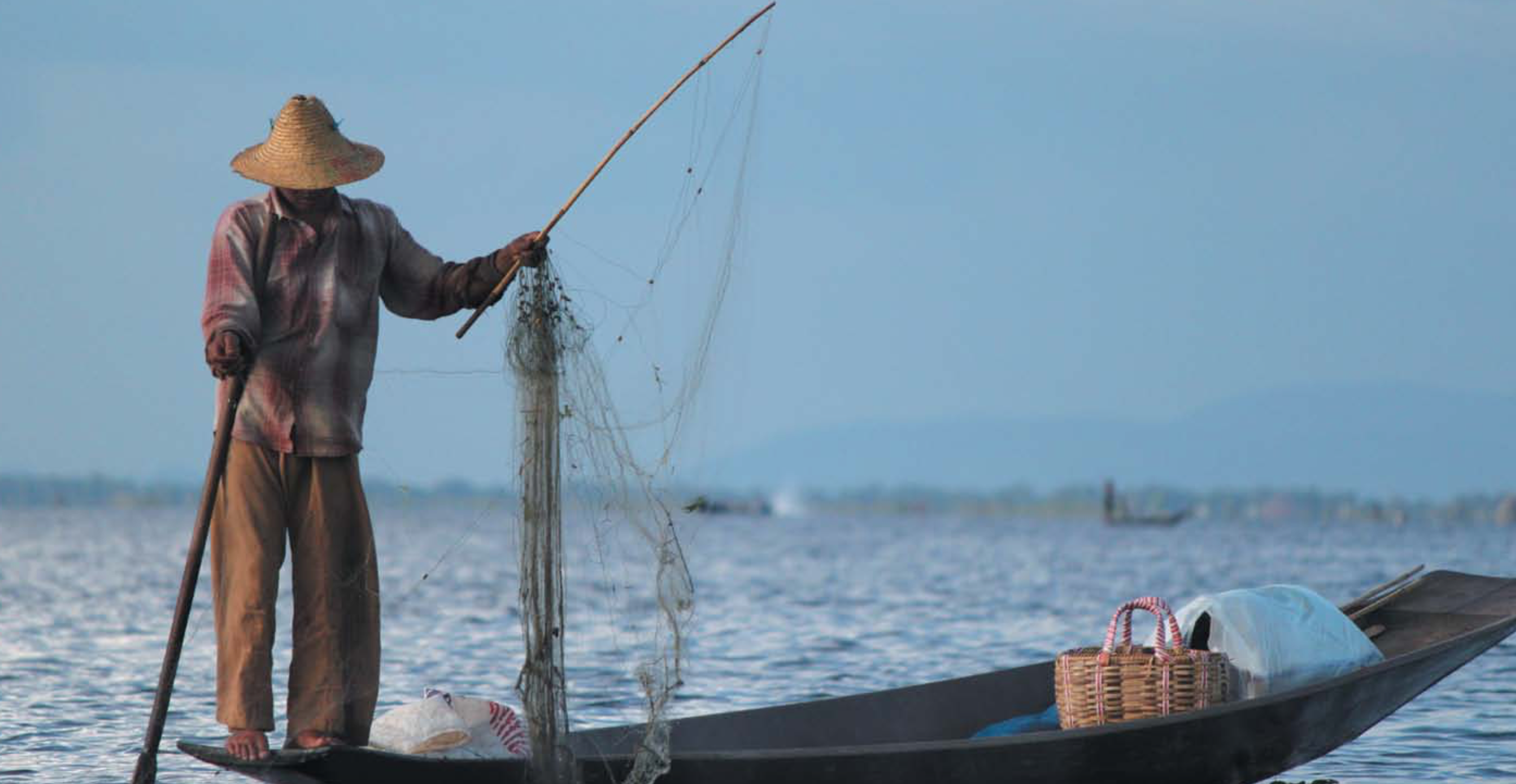
Inle Lake
Ringed by small fishing villages and majestic rolling hills, Inle Lake offers a scenic insight into rural life in Burma. The Intha people live on the lake in houses built on stilts and travel across the water using an unusual style of leg rowing. The lake stretches for 35 kilometres and the best way to explore is by boat. On a day trip you can visit local villages where silk weaving and cheroot rolling are a way of life, watch blacksmiths and silversmiths at work, and see the floating market that moves between the area’s villages on a five day rota. Within the vicinity of Inle Lake lies the temple complex of Indein, situated along a pretty tributary and surrounded by Pa-O villages, as well as Taung Tho on the western shores of the lake. Nearly two hundred stupas have been discovered here and it is still relatively undeveloped.
Trekking between Kalaw & Inle Lake
The wonderful rolling countryside between Kalaw and picturesque Inle Lake shelters some unspoiled minority villages, including Palaung, Pa-O, Taungthu and Danu communities. Off the beaten track and far from any road, the best way to explore is by trekking, spending a night in a monastery along the way. There are several routes available and the most challenging takes you from your starting point of Baw Nin Khone village near Kalaw to either Indein or to Than Daung, a tree-lined route which offers respite from the sun. The simple overnight stays in local monasteries are fantastic, authentic experiences, giving you a rare insight into a time-honoured way of life.
Pindaya
Pindaya is a pretty town and is a great base for gentle walks or steeper treks into the Shan hills. The town is most well-known for its extensive cave network which is shrouded in folklore and houses a huge selection of Buddha images. Pindaya is also renowned for its handicrafts and you can visit a paper parasol workshop or share lunch with a Danu family at a local village and spend time observing the various cottage industries that are based here.

Loikaw
Loikaw, the capital of Kayah State, is a worthwhile visit for the adventurous. The town surrounds the Thiri-Mingalar Taung Kwae Pagoda which is perched high up on a dramatic limestone monolith and affords great views of Loikaw and the surrounding mountain ranges, especially at sunset. In the local villages the Padaung people continue their tradition of wearing gold (or copper) coils around their necks, upper shins and wrists as a demonstration of family wealth. Village visits are accompanied by a local guide and carefully planned to ensure that they are non-intrusive. Loikaw is reached by a five hour road and boat journey from Inle Lake or a four hour trip from the capital, Naypyidaw. A permit is required, which has restricted the number of visitors and consequently limited the tourist infrastructure, but this is expected to change.
Kyaingtong (Kengtung)
This sleepy town nestled deep in the far eastern Shan state forms part of the Golden Triangle that extends into northern Thailand and Laos. The area is a charming, seldom-seen part of Burma, and a highlight of any itinerary. Due to the influence of its neighbouring countries, the temples and monasteries here are quite distinctive, and the early morning and central markets are a great opportunity to see many of the local hill tribes. You can also go trekking to the surrounding villages, where tribes such as the Wa, Ann, Akha, Palaung and Lahu can be seen working the fields in their traditional dress. Further afield, Loimwe is a pretty colonial hill station with period buildings and terraced rice fields. Accommodation options in Kyaingtong are limited to small, simple properties.
Travel Off the beaten track in Myanmar
Getting into the more remote areas of Burma is incredibly rewarding for those with an intrepid spirit. However, some of these destinations are subject to changing permit requirements or travel embargoes from international governments. Our specialist will be able to advise you.
Mrauk U
Mrauk U was the cosmopolitan capital of Rakhine State from the 15th to the 18th centuries and still retains traces of its halcyon days. Inside the old city walls are countless abandoned temples, with ruins in every field and on top of every hill. In this site on the banks of the Aungdat Chaung River, three kingdoms had their capitals, but today there is just a charming, sleepy town with friendly, easy-going people. The most impressive ruins are of Shittaung and Kothaung, but with time you can also visit the ancient city of Wethali and the original site of the famous Mahu Muni Buddha image, now displayed in Mandalay.
A worthwhile visit further afield is a boat journey along the Lay Mro River, stopping off at several traditional Chin villages. You will have the chance to meet the Chin families who live here, and see their ancient but living traditions in the intricately tattooed faces of female elders. Mrauk U is reached by boat along the Kaladan River or by road from Sittwe (a short flight from Yangon).

Putao
Nestled in the foothills of the snow-capped Himalaya, the small town of Putao remains isolated from the outside world by jagged peaks clad in dense, impenetrable forest. This is the country’s northernmost outpost and is an area of rugged wilderness where India, China and Burma meet dramatically against the backdrop of Hkakabo Razi, Southeast Asia’s highest mountain. Unsurprisingly, Burma’s most exhilarating outdoor adventures can be undertaken here. River, trekking into the dense forested hills of the Putao Valley and making cultural journeys to Rawang tribal villages. Eight traditionally- styled cabins placed discreetly amongst bamboo groves recreate a sense of village life but with many home comforts. Each room is centred around its own log fire and features an enormous handcrafted teak bathtub.
Myitkyina & Indawgyi Lake
Myitkyina is best reached by air from Mandalay and is the capital of Kachin State, in the far north. Situated in a broad valley surrounded by forested hills, the area offers excellent hiking opportunities to traditional Kachin villages that have been strongly influenced by visiting Christian missionaries. Nearby is the beautiful Indawgyi Lake, one of the largest in Southeast Asia, and Myit-Son, which is where the Malikha and Mehka rivers converge and the Ayeyarwady River begins its stately journey south. Myitkyina also hosts an important festival in January when all seven tribal groups of Kachin State, each dressed in traditional costume, come together in colourful celebration.
Myeik (Mergui) Archipelago
In southern Burma, some 800 unspoiled and idyllic islands form the Myeik Archipelago. Travelling across the Andaman Sea to your accommodation, you will pass the tiny islands of the archipelago and see your only neighbours, the Moken (sea gypsies) who live in their simple, hand-crafted boats, fishing and diving for pearls. This undeveloped region of outstanding natural beauty is difficult and costly to access and consequently sees few visitors, but offers a spectacular escape for those who make it here. Getting to the area is by a flight from Yangon to Kawthaung, with a number of stops en route, or from Ranong, across the border in Thailand.
Ngwe Saung
Ngwe Saung is relatively unexplored as it is still rather difficult to get to. It is well worth it however, to experience this unspoiled, 15 kilometre stretch of white-sand beach lapped by gloriously clear waters and home to local fishing villages. There are several good resorts here and not a lot else, offering a rare opportunity to truly escape. Flights to the area are infrequent, so the journey involves a five hour drive through the Ayeyarwady Delta from Yangon via Pathein, an interesting stop-off point best known for its colourful handmade parasols.
SY Meltemi
This French-built catamaran is designed for smooth sailing with plenty of space to relax. The vessel has four comfortable guest cabins, each with a king-sized bed, en suite bathroom and air conditioning. The spacious owner’s suite has its own couch area and a generous bathroom. A bright, wooden interior gives SY Meltemi a modern feel. There is also a central saloon and galley. She is well equipped to give a comfortable and adventurous experience while cruising around the Myeik Archipelago.
Meta IV
The Meta IV is a two mast, 80 foot yacht, constructed entirely of Thai teak. Although originally built in 1998 as a private yacht, in 2012 it was fully restored and refitted by Burma Boating to start its new life as a charter vessel exploring the deserted islands of the Myeik Archipelago. The yacht has four air-conditioned cabins, two double and two twin, and all with en suite bathrooms. It is possible to join a six day trip departing weekly between November and April, but for those travelling as a group or who prefer greater flexibility and privacy, it is possible to charter the entire boat. There are indoor and outdoor dining areas and a library, as well as sea kayaks, snorkelling and fishing gear available for your use.
Traveling to experience Festivals and Celebrations in Myanmar
We recommend planning your travel to Myanmar to coincide with one of the many festivals that take place throughout the year such as the Ananda Pagoda Festival in Bagan during January or the Shwedagon Pagoda Festival in March. The Thingyan ‘Water’ Festival is one of the most fun and is usually held for a five day period during April. On the eve of the Buddhist New Year, young and old up and down the country wash away the bad deeds of the previous year in preparation for the next by dousing anyone and everyone in water. For those willing to make the journey from Bagan, the Chin Festival, held in February in the town of Mindat, offers a fascinating glimpse into the unique culture of the Chin tribe. Tribal communities from remote villages gather in a colourful spectacle of costumes, tattoos and jewellery.
Phaung Daw Oo Pagoda Festival
During October, the magical sight of the famous Phaung Daw Oo Pagoda Festival takes place. Four of the five revered gold Buddha images from the temple are carried on an ornate ceremonial barge during this two week long celebration. With a considerable entourage, the procession tours each of the villages around the lake, resting overnight at local monasteries and bringing blessings to all.
Taunggyi fire-balloon festival
During the full-moon celebrations in October/November, Taunggyi, the capital of Shan state, plays host to the annual fire-balloon festival. The festival comes to life at dusk as huge, hand- crafted hot-air balloons are set off into the sky and according to local beliefs, carry all sins away with them.
What to eat in Myanmar [Burma]
Myanmar’s cuisine is part of its culture and reveals a lot of secrets about how Burmese live. Myanmar’s food has been influenced by different countries such as India, Thailand and China, therefore it is not surprising that the main ingredients are rice, nooddles or spicy curry. Myanmar’s food is nutritious and quite appetizing, but as a negative point it is not varied, therefore if you are in the country a long time you can end up tired of always eating the same food everyday.
Typical dishes to eat in Myanmar mixed with different ingredients beside the rice, or noodles such as: vegetables, lentils, fish, chicken and or beef.
- Htamin: Steamed White Rice
- Htaminjo: Fried Rice
- Mohinga: Rice noodles with fish sauce
- Han khauk-swe: shan style noodle soup based on fine wheat noodles in a broth with meat or tofu
- Hinjouyouyou: large assortment of rice soups, shrimp, duck, fish, etc
- Ngapi: it is the most famous dish and consists of a fermented shrimp paste accompanied by vegetables
- Tomato salad: refreshing and very cheap, often referred as a garden salad
Want More reason to travel to Myanmar? Watch this Myanmar Travel Video
Copyright 2013-2017 Vietnamese Private Tours Ltd With Vietnam Luxury Travel



